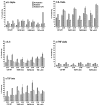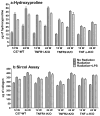Effects of lipopolysaccharide on the response of C57BL/6J mice to whole thorax irradiation
- PMID: 22985778
- PMCID: PMC3632095
- DOI: 10.1016/j.radonc.2012.08.003
Effects of lipopolysaccharide on the response of C57BL/6J mice to whole thorax irradiation
Abstract
Background and purpose: Inflammatory and fibrogenic processes play a crucial role in the radiation-induced injury in the lung. The aim of the present study was to examine whether additive LPS exposure in the lung (to simulate respiratory infection) would affect pneumonitis or fibrosis associated with lung irradiation.
Material and methods: Wildtype C57Bl/6J (WT-C57) and TNFα, TNFR1 and TNFR2 knockout ((-/-)) mice, in C57Bl/6J background, were given whole thorax irradiation (10 Gy) with or without post-irradiation intratracheal administration of LPS (50μg/mice). Functional deficit was examined by measuring breathing rate at various times after treatment. Real-time Reverse Transcription-Polymerase Chain Reaction (RT-PCR) and immunohistochemistry were used to analyze the protein expression and m-RNA of Interleukin-1 alpha (IL-1α), Interleukin-1 beta (IL-1β), Interleukin-6 (IL-6), Tumour Necrosis Factor alpha (TNFα) and Transforming Growth Factor beta (TGFβ) in the lung at various times after treatment. Inflammatory cells were detected by Mac-3 (macrophages) and Toluidine Blue (mast cells) staining. Collagen content was estimated by hydroxyproline (total collagen) and Sircol assay (soluble collagen). Levels of oxidative damage were assessed by 8-hydroxy-2-deoxyguanosine (8-OHdG) staining.
Results: LPS exposure significantly attenuated the breathing rate increases following irradiation of WT-C57, TNFR1(-/-) and TNFR2(-/-)mice and to a lesser extent in TNFα(-/-) mice. Collagen content was significantly reduced after LPS treatment in WT-C57, TNFR1(-/-) and TNFα(-/-) mice and there was a trend in TNFR2(-/-) mice. Similarly there were lower levels of inflammatory cells and cytokines in the LPS treated mice.
Conclusions: This study reveals a mitigating effect of early exposure to LPS on injury caused by irradiation on lungs of C57Bl mice. The results suggest that immediate infection post irradiation may not impact lung response negatively in radiation-accident victims, however, further studies are required in different animal models, and with specific infectious agents, to confirm and extend our findings.
Copyright © 2012 Elsevier Ireland Ltd. All rights reserved.
Conflict of interest statement
Figures




Similar articles
-
Compartmental responses after thoracic irradiation of mice: strain differences.Int J Radiat Oncol Biol Phys. 2005 Jul 1;62(3):862-71. doi: 10.1016/j.ijrobp.2005.02.037. Int J Radiat Oncol Biol Phys. 2005. PMID: 15936571
-
Dose-dependent induction of transforming growth factor beta (TGF-beta) in the lung tissue of fibrosis-prone mice after thoracic irradiation.Int J Radiat Oncol Biol Phys. 2000 Jul 1;47(4):1033-42. doi: 10.1016/s0360-3016(00)00482-x. Int J Radiat Oncol Biol Phys. 2000. PMID: 10863076
-
The bronchiolar epithelium as a prominent source of pro-inflammatory cytokines after lung irradiation.Int J Radiat Oncol Biol Phys. 2005 Apr 1;61(5):1482-92. doi: 10.1016/j.ijrobp.2004.12.072. Int J Radiat Oncol Biol Phys. 2005. PMID: 15817354
-
Modeling radiation-induced lung injury: lessons learned from whole thorax irradiation.Int J Radiat Biol. 2020 Jan;96(1):129-144. doi: 10.1080/09553002.2018.1532619. Epub 2018 Oct 25. Int J Radiat Biol. 2020. PMID: 30359147 Free PMC article. Review.
-
A survey of changing trends in modelling radiation lung injury in mice: bringing out the good, the bad, and the uncertain.Lab Invest. 2016 Sep;96(9):936-49. doi: 10.1038/labinvest.2016.76. Epub 2016 Aug 1. Lab Invest. 2016. PMID: 27479087 Review.
Cited by
-
Long intergenic non-coding RNA induced by X-ray irradiation regulates DNA damage response signaling in the human bronchial epithelial BEAS-2B cell line.Oncol Lett. 2015 Jan;9(1):169-176. doi: 10.3892/ol.2014.2622. Epub 2014 Oct 17. Oncol Lett. 2015. PMID: 25435953 Free PMC article.
-
Neuroinflammatory and cognitive consequences of combined radiation and immunotherapy in a novel preclinical model.Oncotarget. 2017 Feb 7;8(6):9155-9173. doi: 10.18632/oncotarget.13551. Oncotarget. 2017. PMID: 27893434 Free PMC article.
-
The Influence of Radiotherapy on AIM2 Inflammasome in Radiation Pneumonitis.Inflammation. 2016 Oct;39(5):1827-34. doi: 10.1007/s10753-016-0419-y. Inflammation. 2016. PMID: 27525422
-
Targeting the Renin-angiotensin system combined with an antioxidant is highly effective in mitigating radiation-induced lung damage.Int J Radiat Oncol Biol Phys. 2014 Jul 15;89(4):722-8. doi: 10.1016/j.ijrobp.2014.03.048. Epub 2014 May 24. Int J Radiat Oncol Biol Phys. 2014. PMID: 24867538 Free PMC article.
-
Massive hemorrhage following definitive esophageal chemoradiation: teaching case of a fatal aortoesophageal fistula and lessons learned.Clin Case Rep. 2017 Nov 7;5(12):2074-2079. doi: 10.1002/ccr3.1239. eCollection 2017 Dec. Clin Case Rep. 2017. PMID: 29225860 Free PMC article.
References
-
- Marks LB, Yu X, Vujaskovic Z, Small W, Jr, Folz R, Anscher MS. Radiation-induced lung injury. Semin Radiat Oncol. 2003;13(3):333–45. - PubMed
-
- Johnston CJ, Piedboeuf B, Baggs R, et al. Differences in correlation of mRNA gene expression in mice sensitive and resistant to radiation-induced pulmonary fibrosis. Radiat Res. 1995;142(2):197–203. - PubMed
Publication types
MeSH terms
Substances
Grants and funding
LinkOut - more resources
Full Text Sources

